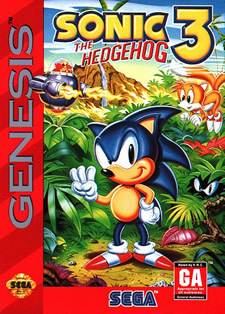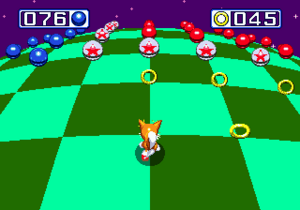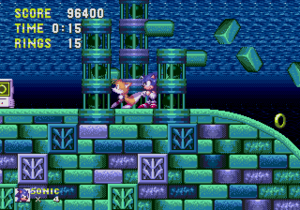Sonic the Hedgehog 3 facts for kids
Quick facts for kids Sonic the Hedgehog 3 |
|
|---|---|

|
|
| Developer(s) | Sega Technical Institute |
| Publisher(s) | Sega |
| Director(s) | Hirokazu Yasuhara |
| Producer(s) | Yuji Naka |
| Designer(s) |
|
| Programmer(s) |
|
| Artist(s) |
|
| Composer(s) |
Brad Buxer
Sega Sound Team
|
| Series | Sonic the Hedgehog |
| Platform(s) | Sega Genesis, Windows |
| Release date(s) | Sega Genesis
Windows
|
| Genre(s) | Platform game |
| Mode(s) | Single-player, multiplayer |
Sonic the Hedgehog 3 is a classic platform game released in 1994 by Sega for the Sega Genesis. In this game, players guide Sonic and his friend Tails through exciting levels. Their mission is to collect Chaos Emeralds. They must stop the evil Doctor Robotnik from relaunching his space station, the Death Egg. This station crashed on a mysterious floating island.
Sonic 3 also introduces a new character, Knuckles the Echidna. Knuckles is the guardian of the island. He often sets traps for Sonic and Tails, making their adventure more challenging. The game was first planned to be one big adventure with Sonic & Knuckles. However, due to time and cost, it was split into two parts. You can combine them by attaching the Sonic 3 cartridge to the Sonic & Knuckles cartridge. This creates a larger game called Sonic 3 & Knuckles.
Contents
Playing the Game: How to Play Sonic 3
Sonic the Hedgehog 3 is a 2D side-scrolling platform game. You can play as Sonic, Tails, or both at the same time. If you choose Sonic, Tails will follow him. Another player can join in and control Tails. Tails has a special ability: he can fly for a short time. He spins his two tails like a helicopter rotor. When he gets tired, he falls. Tails can also swim underwater, which Sonic cannot do.
The game has six main areas called "zones." Each zone has two parts, or acts. These levels are full of "badniks," which are robots made by Dr. Robotnik. Sonic and Tails can defeat them by jumping on them. They can also use a "spin dash" attack. This attack also gives them a burst of speed.
Levels have many obstacles. These include vertical loops, corkscrews, and walls that can be broken. There are also spikes, water where you can drown, and endless pits. At the end of the first act, you fight a smaller boss robot. At the end of the second act, you face a big boss fight with Dr. Robotnik. The game saves your progress when you reach a new level. There are six save slots.
Rings, Power-ups, and Lives
Like other Sonic games, Sonic 3 uses rings as a health system. If you have rings and get hit, you lose your rings but stay safe. If you get hit without rings, get crushed, fall off the screen, or drown, you lose a life. You then restart from the last checkpoint. If you run out of lives, it's a game over.
Levels also have special power-ups inside television monitors. Hitting these monitors can give you:
- An extra life
- Temporary invincibility
- More rings
- A shield to breathe underwater
- A shield against fire attacks
- A shield that pulls nearby rings towards you
Special Stages and Chaos Emeralds
Sonic 3 has two kinds of "special stages."
- The first type appears if you collect at least 50 rings and pass a checkpoint. You enter a bouncy corridor, like a gumball machine. You bounce up to earn power-ups.
-
 Tails in one of the special stages, where players can earn Chaos Emeralds
Tails in one of the special stages, where players can earn Chaos Emeralds
The second type is found by jumping into giant rings in secret spots. In these stages, you run around a 3D map. Your goal is to pass through all the blue spheres. If you touch a red sphere, you leave the stage. But if you complete a circle around blue spheres, they turn into harmless rings. If you clear all the blue spheres, you earn a Chaos Emerald. If Sonic collects all seven Chaos Emeralds, he can become Super Sonic. Super Sonic is invincible to most dangers. If you don't collect all seven, Robotnik and Knuckles will tease you at the end.
Competitive Play in Sonic 3
Sonic 3 also has a competitive mode for two players. You can race as Sonic, Tails, or Knuckles. There are five special stages just for this mode. You can race through one or all of them. You can also play these stages alone in a time attack mode to beat the clock.
Sonic 3 & Knuckles: The Full Adventure
Sonic the Hedgehog 3 and Sonic & Knuckles were meant to be one big game. But they were released separately because of time limits and the cost of the game cartridge. The Sonic & Knuckles cartridge has a special "lock-on" part. You can attach other Genesis cartridges to it. If you connect the Sonic 3 cartridge, it creates the combined game, Sonic 3 & Knuckles. Most newer versions of the game also let you do this.
In Sonic the Hedgehog 3 & Knuckles, you can play Sonic 3 levels as Knuckles. You can also play Sonic & Knuckles levels as Tails. You can even play as both Sonic and Tails together. Other cool new features include:
- Collecting Super Emeralds to unlock "Hyper" forms for Sonic and Knuckles. Tails gets a "Super" form too.
- Better save options.
- Access to areas that Sonic or Tails couldn't reach before.
- Different boss fights.
- An extra ending where Sonic returns the Master Emerald to Angel Island.
Story of Sonic the Hedgehog 3
After Sonic and Tails defeat Dr. Robotnik in Sonic the Hedgehog 2, Robotnik's space station, the Death Egg, crashes. It lands on a floating place called Angel Island. On the island, Robotnik meets Knuckles the Echidna. Knuckles is the last of an ancient echidna group that lived there. He guards the Master Emerald. This emerald gives the island its power to float. It is as powerful as the seven Chaos Emeralds.
Robotnik tricks Knuckles into thinking Sonic wants to steal the Master Emerald. This makes Knuckles fight Sonic. Meanwhile, Robotnik secretly fixes the Death Egg. Sonic and Tails fly to Angel Island in their biplane, the Tornado. Sonic uses the Chaos Emeralds to become Super Sonic. But Knuckles surprises him and steals the emeralds. Sonic and Tails travel across the island, facing challenges from both Knuckles and Robotnik.
At the Launch Base, where the Death Egg is being fixed, Sonic and Tails fight Knuckles. But the Death Egg takes off again. On a platform attached to the Death Egg, they defeat Robotnik. This makes the Death Egg crash back onto Angel Island. The story continues in Sonic & Knuckles.
Making the Game: Development of Sonic 3
Sonic the Hedgehog 3 was made in California by Sega Technical Institute (STI). The team started working on it in January 1993. They had a deadline of February 1994. This was because Sega and McDonald's planned a big promotion in America.
At first, the team thought about using a new chip for 3D graphics. They even made a test version with isometric graphics. This version was called Sonic 3D. But the chip wasn't ready in time. So, Sonic 3 became a regular 2D platform game. The 3D idea was later used for Sonic 3D Blast in 1996.
The creators wanted a deeper story for Sonic's world. This made the game very big. The levels are three times larger than those in Sonic 2. Many ideas for Sonic 3 were first thought of during Sonic 2's development.
Sonic 3 and Sonic & Knuckles were originally planned as one game. But there wasn't enough time. Also, a very large game cartridge with special memory would have been too expensive. So, the team decided to split the game into two parts. This gave them more time for the second part. It also split the cost between two cartridges. The "lock-on" technology on the Sonic & Knuckles cartridge was made so players could still experience the game as one.
Sonic 3 was the first game to feature Knuckles the Echidna. Many different designs for Knuckles were considered. The final design was chosen by Takashi Yuda. Knuckles was meant to be a strong character. While Sonic is about speed, Knuckles is about power. He can break walls. His shoe colors were inspired by the Jamaican flag.
Game Release and Availability
Sonic 3 was released in North America on February 2, 1994. It came out in Europe on February 24, and in Japan on May 27. Sega spent a lot of money to promote the game in the United States. In Europe, the band Right Said Fred changed their song "Wonderman" to include Sonic. This song was used in Sonic 3 ads.
Where to Find Sonic 3 Now
Sonic 3 has been included in many game collections over the years. Some of these are:
- Sonic Jam (1997) for Sega Saturn
- Sonic Mega Collection (2002) for GameCube
- Sonic Mega Collection Plus (2004) for PlayStation 2, Xbox, and Windows
- Sonic's Ultimate Genesis Collection (2009) for Xbox 360 and PlayStation 3
- Sonic Classic Collection (2010) for Nintendo DS
The game was also released for the Wii Virtual Console in 2007. It came to Xbox Live Arcade in 2009. A PC version, Sonic 3 & Knuckles, was released on Steam in 2011.
Sonic 3 was not on the Sega Genesis Mini console (2019). This was likely due to issues with the game's music rights. In 2014, some independent developers wanted to make a new version of Sonic 3 & Knuckles for mobile phones. But Sega did not go forward with the project. This was also likely because of music legal issues.
Sonic 3 & Knuckles was re-released in 2022 as part of the Sonic Origins collection. This version is a new remaster. The music in this version was rearranged by Jun Senoue. He used the original Genesis sound chip to create new versions of the songs.
Sonic 3's Impact: Legacy
Sonic 3 was the first game to feature Knuckles the Echidna. Knuckles became a very important character in later Sonic games. Comic books like Sonic the Comic (UK) and the Archie Sonic the Hedgehog comic (US) also told stories based on the game.
For Sonic's 20th anniversary, Sega released Sonic Generations. This game remade parts of many old Sonic games. The Nintendo 3DS version of Sonic Generations has a remake of the final boss from Sonic 3, called "Big Arms." The Angel Island and Hydrocity levels from Sonic 3 were also remixed in Sonic Mania (2017).
|
See also
 In Spanish: Sonic the Hedgehog 3 para niños
In Spanish: Sonic the Hedgehog 3 para niños


